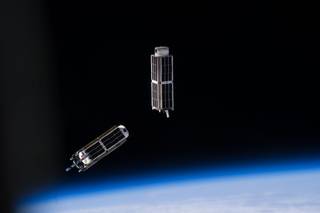Secure Your Mission - Shape Memory Alloy Actuators
Lightweight and efficient mechanism for retention, release, and deployment of solar arrays and antennas
Can you afford a mission loss from an actuator failure? This may be one of the most overlooked subsystems on today’s spaceflight missions. Many SmallSats fail because a solar panel or an antenna does not deploy. However, this is completely unnecessary with current advances in shape memory alloys (SMAs). Why leave your expensive satellite mission up to chance? Orbotic Systems can provide you with an actuator solution that will save you from an unexpected release failure.
We have teamed up with NASA to offer you lightweight and reliable mechanisms based on SMAs for small satellites, including CubeSats. SMAs have the unique ability to effect reversible phase transformation, so they can withstand being severely deformed and restored repeatedly. Our technology has flown on successful space missions and uses SMA components in actuators and hinging elements. This results in a marked improvement of retention, release, and deployment for crucial structures, including solar arrays.
Compared to standard devices, SMA-based mechanisms are much smaller and lighter, do not produce debris, and require minimal power to operate. They also meet the rigorous power budget for CubeSats. These mission critical, SMA-based components, are a key breakthrough because of low weight, reusability, and reliability. Additionally, SMA mechanisms are scalable, so their benefits can be realized for larger spacecraft.
Benefits
- Lightweight/compact: The SMA retention and release device weighs between 150 and 200 grams (for 3U CubeSats), and is fully scalable to smaller or bigger satellites.
- Low-power: Deploys in as little as 10 seconds, using only 18 watts.
- Efficient: SMA components are resettable, so they can be ground-tested several times, unlike current state of the art.
- Clean and safe: Does not require additional lubrication and unlike pyroytcchnics and burn wires, does not create debris.
- Versatile: Tunable to operate in a wider range of deployment temperatures (-140 to 500 degrees C) than previous devices, enabling missions in extreme temperature environments.
Schedule a call with our team to discuss your mission objectives. We can provide you with a standard solution for CubeSats or develop a custom application for your specific mission profile.

